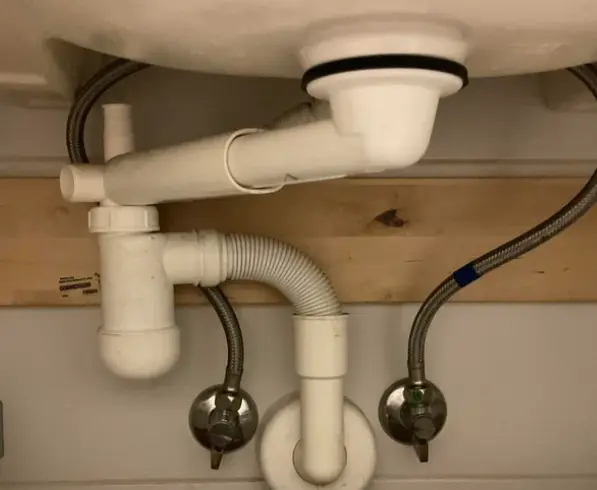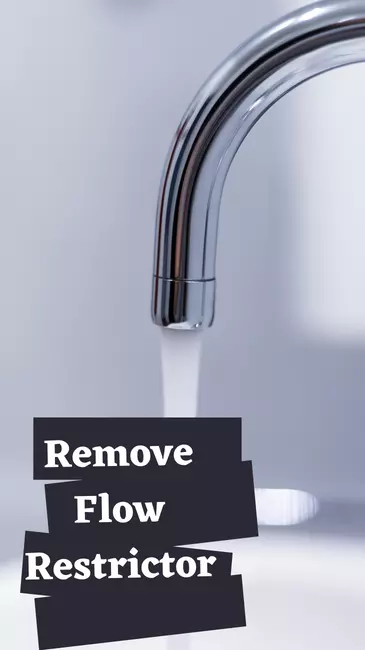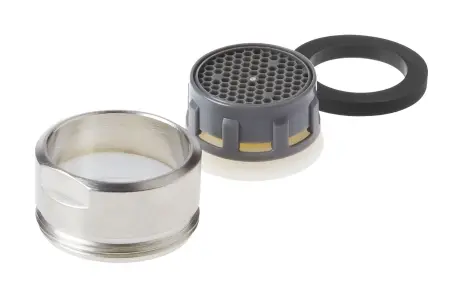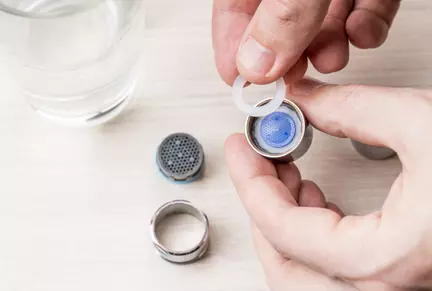If the flow restrictor in the Kohler kitchen faucet is clogged or damaged, you won’t get enough water flow to wash dishes. You can remove this flow restrictor to get back water pressure in the normal condition.
The Kohler faucet flow restrictor removal process is straightforward. First, you need to remove the Kohler kitchen faucet aerator and then you can remove the flow restrictor behind the aerator. The detailed process of removing the Kohler kitchen faucet is explained in this guide.
SALE
Moen Sleek Chrome Touchless One-Handle High Arc Faucet
Touchless activation | Flexible Design | Power Clean spray technology | Easy-To-use | Duralock quick connect system
Kohler K-22973-CP Pre-Rinse Kitchen Sink Faucet
DockNetik magnetic docking system | Three-function pull-down sprayhead | Quiet braided hose| Easy-To-clean surface | High-arch swing spout
How To Remove Flow Restrictor From Kohler Kitchen Faucet?
It is important to have the right tools to remove the Kohler faucet flow restrictor. With the right tools, without damaging the faucet, you can quickly start the Kohler kitchen faucet flow restrictor removal process.
- Plier
- Screwdriver
- Aerator removal key (For some Kohler faucets)
- Towel
One thing you should keep in mind is that not all Kohler faucets have a flow restrictor. So, a flow restrictor is not the only reason for the low water pressure in the Kohler faucet, it might be some other issues in the faucet. Here is the process to remove the flow restrictor safely from the Kohler kitchen faucet.
Shut off The Water Valve

Check that the water supply to the faucet is shut off. Turn off both the hot and cold water supplies if they are separate. Turn on the Kohler kitchen sink faucet to drain any residual water from the faucet pipe.
Cover The Sink Drain

You may lose smaller parts of the faucet into the sink drain while removing a flow restrictor. To prevent any part from falling into the sink drain, cover the sink drain with a towel.
If you have a sink stopper, you can use it to cover the sink drain.
Remove The Flow Restrictor

Now you are ready to remove the flow restrictor of the Kohler kitchen faucet.
First, remove the aerator and then you can remove the flow restrictor.
Some aerators can be removed by using a hand. First, try with a hand to remove the aerator. If the aerator is stubborn, you need to use a plier. Grab the aerator with a plier. Now turn the plier counterclockwise to loosen the aerator.
After removing the aerator, you can see the flow restrictor. Use a plier to remove this flow restrictor. You might have to use some force to get the flow restrictor out from the faucet.
Now reattach the aerator to the faucet after removing the flow restrictor. Before reattaching the aerator, you should clean the aerator with vinegar to open its clogged holes.
Do You Need a Flow Restrictor In a Faucet?
The requirement of the flow restrictor depends on your daily routine cleaning tasks in the kitchen.
A flow restrictor generally slows down the water pressure of the faucet. You will get more water pressure from other faucets of the house that don’t have any flow restrictors. So, you might be thinking of removing the flow restrictor from your Kohler faucet.
In some conditions, it is essential to remove the flow restrictor. You can easily remove it by following the above-mentioned steps. But be ready for a higher water bill and water hammering to dishes.
When you remove a flow restrictor, your daily water usage goes high. It increases the monthly water bill.
Without a flow restrictor, the water pressure goes high. When the water comes out from the faucet, it feels like hammering on dishes. You need to use a flow restrictor to avoid these issues.
Are The Aerator and Flow Restrictor The Same Things?

People often get confused between the aerator and the flow restrictor. The aerator and flow restrictor are two different things. Both are parts of the faucet and are used to control the flow of water.
The aerator is a device that mixes water with air to create a consistent and smooth flow of water. The aerator is located at the end of the faucet spout.
The aerator helps to create a more even flow of water. This water flow makes it easier to wash dishes, rinse food, and perform other tasks. It also reduces splashing and dripping, which can help prevent messes and make cleanup easier.
A flow restrictor, on the other hand, is a device that regulates the amount of water that flows through the faucet. Its primary purpose is to limit water consumption, helping households conserve water and save money on their utility bills.
The flow restrictor is usually located within the faucet body or beneath the aerator. It works by creating resistance in the water flow, which reduces the volume of water that comes out of the faucet. It doesn’t make the water flow smooth.
Should You Reuse or Replace The Faucet Flow Restrictor?
The faucet flow restrictor is designed to limit the use of water. If the flow restrictor is clogged or damaged, instead of removing it, you should clean or replace it with a new one to control water use. If you remove it permanently, it will increase the water usage and water bill of your house.
Clean The Flow Restrictor To Reuse It
A clogged flow restrictor is the reason for the low water pressure issue in the Kohler faucet. Its solution is pretty simple and requires only white vinegar and water to clean it. The flow restrictor is clogged by buildup and slows the water pressure. If you clean it regularly, the chances of clogging are less.
Take a bowl to mix water and white vinegar into equal quantities. This cleaning solution will remove buildups from the faucet flow restrictor.
Dip the water flow restrictor in the solution for an hour. Take it out from the solution and use a toothbrush to loosen all debris and buildup. Rinse it with clean water. If the flow restrictor is in good condition, you can use it again.
Replace The Flow Restrictor

If the faucet flow restrictor is damaged and cannot be reused, it is time to replace it. That is a minor component that will not cost you much.
Reattach the aerator to the faucet after inserting the new flow restrictor. Tighten it properly using a plier. Now go to the water valve and turn it on.
Why New Kohler Faucet Low Pressure?
You have recently bought a new Kohler faucet but its water pressure is low. In the new Kohler faucet low pressure might be due to the flow restrictor or low water pressure in your house.
You should check whether the shut-off valve is fully opened or not. If not, turn it in a clockwise direction to open them. You can also remove the Kohler faucet water restrictor to increase the water pressure.
FAQs
Will Remove The Flow Restrictor From a Kohler Kitchen Faucet Increase Water Pressure?
Not in every situation, you get a high water pressure when you remove the sink flow restrictor. If the faucet cartridge is damaged, the faucet body is clogged, or any other issue with the faucet, you won’t get high water flow even after removing the flow restrictor.
Will Remove The Flow Restrictor From My Kohler Kitchen Faucet Void The Warranty?
Yes, if you remove the flow restrictor of the Kohler kitchen faucet, it will void its warranty. Kohler faucets are covered with the warranty to cover defects and malfunctions during normal use of the faucet.
Do Kitchen Faucets Have a Flow Restrictor?
Not all faucets come with a flow restrictor. If the manufacturer feels that any faucet model needs a flow restrictor, it installs the restrictor. The aerator also slows down the water pressure so not all faucets have a flow restrictor.
Final Thoughts
Removing the flow restrictor of the Kohler kitchen faucet is beneficial for some people, but not for everyone. Before removing it, you should think about your daily requirements and needs of water for cleaning. If your water pressure is not enough, you can remove the flow restrictor from the Kohler faucet. But it will also increase your water bill.

James Lewis is a seasoned plumber and faucet enthusiast who shares his expertise on Faucetsavvy.com. With over 15 years of experience in the plumbing industry, he’s passionate about helping homeowners find the perfect faucet for their needs. He’s also dedicated to empowering DIY enthusiasts with the plumbing knowledge and skills needed to repair and maintain their faucets.
Recommended By Faucetsavvy's Team
Best Kitchen Faucets of 2025: Sleek, Durable & Worth Every Penny Check Our Review





I have a Kohler bathroom faucet that is brand new. The flow is very low compared to my previous faucet. I have no water bill because my own well supplies the water. How do I increase the flow of my new Cursiva 4 in. Centerset Double Handle Bathroom Faucet in Vibrant Brushed Moderne Brass?
Check the aerator at the tip of the faucet spout—it often comes with a flow restrictor. Unscrew it and either clean or remove the restrictor to increase flow. If that doesn’t help, ensure the supply valves under the sink are fully open.